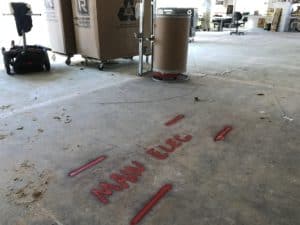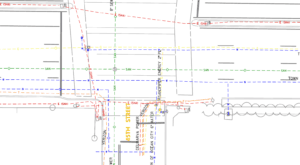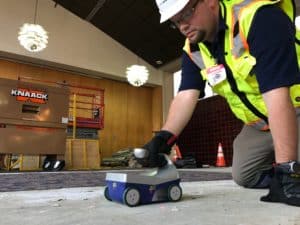Concrete Scanning & Imaging
We can locate utilities indoors and under floors
Unlike the 811 system, Utility Locator, LLC can locate existing utilities inside a building. Whether you need to core though multiple floors, or need to saw cut a trench in the basement / ground floor level, our team of skilled utility locators can detect and mark-out utilities and structural members embedded in and below concrete walls, floors, and columns. We can even locate sanitary sewer lines under the concrete floor for your future tie-in. Call us today for a free quote at (888) 232-5959.
Commonly called “Floor X-Ray,” or “Concrete X-Rays,” our concrete imaging radar works much like our standard Ground Penetrating Radar, and doesn’t use the hazardous radiation found with x-ray imaging systems. Concrete imaging radar utilizes the same GPR technology to detect conflicts such as reinforcement, conduit, cables, piping, post tension cables, and more in concrete floors, slabs, walls, columns, and other surfaces.
 Concrete imaging radar utilizes a high frequency radio wave emitted from the radar unit to detect the presence of conflicts. Although this high frequency provides a much higher resolution image compared to traditional ground penetrating radar, it does not provide as much penetration into the scanning surface. On average, we can detect objects up to a depth of 20 inches.
Concrete imaging radar utilizes a high frequency radio wave emitted from the radar unit to detect the presence of conflicts. Although this high frequency provides a much higher resolution image compared to traditional ground penetrating radar, it does not provide as much penetration into the scanning surface. On average, we can detect objects up to a depth of 20 inches.
Concrete imaging radar can also produce an “x-ray like” image. This is created by performing a series of scans in a pre-configured grid pattern. The scans are them compiled in the on-board computer, and can be displayed in real time. Safely core concrete surfaces without any fear of damaging embedded rebar, conduits, cables, or more.
THE DOCUMENTATION YOU NEED TO GET THE JOB DONE RIGHT
 We provide our clients with all of the documentation they need to prove a qualified 3rd party firm provided utility locating support on the project. We include our superior utility mark-out using paint & flags, a project report, professional utility sketch documenting the utilities that were designated, and site photographs at no additional charge.
We provide our clients with all of the documentation they need to prove a qualified 3rd party firm provided utility locating support on the project. We include our superior utility mark-out using paint & flags, a project report, professional utility sketch documenting the utilities that were designated, and site photographs at no additional charge.
Concrete Scanning SERVICES WHERE YOU NEED THEM
Utility Locator® has office locations throughout Pennsylvania, New Jersey, Delaware, and Maryland. We are quickly becoming the area’s largest and most reliable source for concrete scanning & imaging services.
PENNSYLVANIA/ Lancaster, Media, & Jenkintown
NEW JERSEY / Piscataway Township
DELAWARE/ Wilmington
MARYLAND/ Ellicott City
You’ve got questions, we’ve got answers
How does concrete imaging radar work?
Concrete imaging radar works by transmitting a radio frequency signal into the concrete surface. When the signal is reflected off concrete and other embedded members, a visual response is registered on the monitor, allowing technicians to mark the location of the observation in real time.
Do you use x-ray to scan and image concrete surfaces?
Commonly called “Floor X-Ray,” or “Concrete X-Rays,” our concrete imaging radar works much like our standard Ground Penetrating Radar, and doesn’t use the hazardous radiation found with x-ray imaging systems. Concrete imaging radar utilizes the same GPR technology to detect conflicts such as reinforcement, conduit, cables, piping, post tension cables, and more in concrete floors, slabs, walls, columns, and other surfaces.
How deep can you locate utilities under a floor?
Concrete imaging radar is effective to image utilities and other commodities embedded within concrete to a depth of about 24 inches. Other technologies are utilized to successfully detect and mark other utilities buried deep below the slab.
Can you find rebar or other reinforcement in concrete?
Yes! Our concrete scanning & imaging services are designed to provide information about conduit, rebar, and other reinforcement embedded within concrete walls, floors, slabs, and columns.
How much room do you need to scan the floor?
When scanning core holes, we will typically need a minimum of 2’x2′ area around the core location. This will allow us to preform a grid scan to make sure we have a clean area laid out for the work to continue.
Can you find thermal / radiant heat systems?
Yes! Radiant heat tubing is detectable using our concrete imaging radar.

